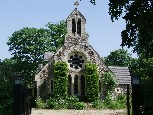| |
|
Braiseworth has
never been big. When the Victorians rebuilt the
decaying medieval church, they did so up on the top
road. It was closer to the few people that there
were. If they had simply tarted up the old building, there is a chance that
Braiseworth would still have a parish church;
little-used, no doubt, but kept in action under
the kind wing of some neighbouring benefice, and
still accessible as a touchstone to the past
generations. But when the Anglican
Diocese set about rationalising its resources in
the 1970s, the Victorian St Mary was always going
to be one of the first to go. Heart-breakingly,
there couldn’t be much argument about this;
far more controversial was the redundancy and
eventual selling off of such gems as Mickfield and Ubbeston. No Redundant Churches
Fund wish-list was ever likely to include this
one, so it too became a private house, and
remains so to this day.
Big
mistake. For in the 1970s, Victorian churches,
and Victorian architects, were not fashionable.
They are today, and as it turns out, this church
was designed by one of the most fashionable of
all, the maverick EB Lamb, most famous in Suffolk
for his seriously weird rebuilding of Leiston. Here, his starting point
was the Norman remains of the old church, but any inspiration that
came from this was transmuted by whatever drugs
he was on at the time. Pevsner describes it as
'Lamb in all his perversity', and positively
purrs with pleasure.
About
ten years ago, when I first added this church to
the site, I received a very polite letter from
the lady who lives in this church, explaining
that I really shouldn’t have Braiseworth on
my site. It was no longer a church, she said, and
could be of no interest. In this, she was quite
wrong, of course; not only is it a very
architecturally significant building, but
hundreds of American and Australian family
history hunters would clamour to disagree with
her. For them, this place is holy ground, as they
reconstruct the past, and learn where they came
from. In this sense I think that, although it is
no longer a church, it is still a spiritual
place.
| Lamb tore
down the nave of the old church, reusing the
Norman doorways here. It was consecrated
in 1857. It must have been a fine sight,
a new church for a new age of optimism.
They could not have imagined that, in a
little more than a century, it would all
be over. Today, the setting
is thoroughly domestic, hedge-surrounded
and gardened.The churchyard was never
used for burials, which continued at the
site of the old church, but when I came
this way ten years ago I saw that still
remaining on private land was the
Braiseworth war memorial. Is it still
there today, I wonder? Now, the hedges
are too high to see. The parish has never
been big enough for it to have many names
on it. But in the years after 1918, there
were families in this parish who saw it
as a focus for their grief, and perhaps
still do today.
|
|
 |
|
|
|

